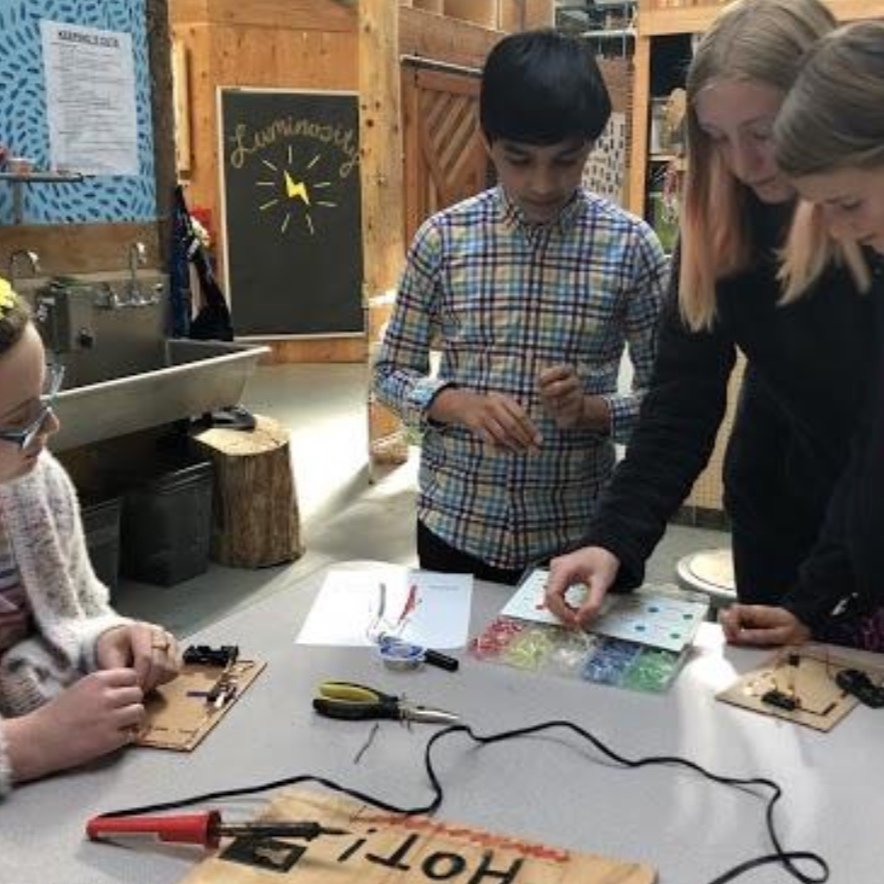Sparking Change
The Amber Band (11 and 12 year olds) explored the Spark arc through three questions: What is your relationship to energy? How does that impact our environment? Why might that inspire us to spark change? They uncovered some important ideas about how electricity works and how our overuse of devices create unintended consequences. Their collaborator Megan tells the story:
The band did a group brainstorm on all the things we're wondering about "spark". Then we made this mind map to help guide our exploration over the next five weeks.
What is your relationship to energy?
The Amber Band took a closer look at our energy usage at Brightworks. This was one of our first attempts as a band to visualize data, and so we focused our data collection on just the lightbulbs on at school over the course of one day. We calculated our approximate kilowatts per hour, generalizing that all of the bulbs were a 75 watt bulb. However, we soon realized that Brightworks utilizes a wide variety of lightbulbs, many of which utilize LEDs, making them more efficient. We talked about why we might want to take a closer look at how much energy we use in a day, and considered some of the other ways we use energy in a day.
What is climate change, and what do patterns in environmental data tell us about our changing atmosphere?
We worked together to graph 10 years worth of carbon dioxide data from the National Oceanic and Atmospheric Administration (NOAA) to learn about natural cycles and unnatural changes in our atmosphere. Our data spanned 10 years from two very different locations (Mauna Loa, Hawaii and the South Pole) to help us see the big picture behind these patterns.
What is conductivity?
We worked with Rich, making circuits and soldering. We used copper tape, LEDs, batteries, and a switch. We learned that if you have two LEDs in a row (in a series) it won't work because there's not enough energy to support both.
What happens to our electronics once their spark is gone?
We took apart old technology to learn about e-waste. E-waste is electronic waste. Many big companies make it so older versions of their products don't last very long. One day, usually when the new version comes out, that old cell phone or laptop starts to run slower. This causes consumers to constantly be updating their technology, and usually people just throw it away or bring it to an e-waste place. We also discussed this Wired article, E-Waste: Dark Side of Digital Age which talks about how some e-waste recycling programs use federal prison labor to recycle old computers, a process which exposes inmates to toxic chemicals without the proper safety protection found in proper recycling facilities.
As we dove into a study of devices we watched this video to consider how even something as simple as a pencil can't be created by one human alone. This simple technology has parts that are mined, logged, and processed all over the world. What are the parts, purposes, and puzzles behind a pencil? What are the parts, purposes, and puzzles behind an old cellphone? A laptop? Some speakers? Kids considered these questions as they dissected their e-waste. We're in then made diagrams of our e-waste to show these parts, purposes, and puzzles.
How might we re-ignite the spark in our e-waste by creating a sculpture that tells its story?
In Agbogbloshie, a community in Accra, Ghana, people descend on a scrapyard to mine electronic waste for recyclable materials. Without formal training, these urban miners often teach themselves the workings of electronics by taking them apart and putting them together again. Designer and TED Fellow DK Osseo-Asare wondered: What would happen if we connected these self-taught techies with students and young professionals in STEAM fields? The result: a growing maker community where people engage in peer-to-peer, hands-on education, motivated by what they want to create. Learn more about how this African makerspace is pioneering a grassroots circular economy. We watched this TED Talk to learn more about this community.
The band was tasked with transforming their e-waste into a sculpture that tells its story—What was it? What is it now? What is its potential as a recycled object? Install your sculpture in a public space for others to interact with your work, and document how your artwork impacts the environment.

















